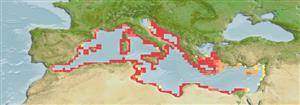>
Eupercaria/misc (Various families in series Eupercaria) >
Labridae (Wrasses)
Etymology: Centrolabrus: Greek, kentron = sting + Greek, labros = furious (Ref. 45335).
More on author: Risso.
Environment: milieu / climate zone / depth range / distribution range
البيئة
بحري مرتبطة بالشعاب; نطاق العمق 1 - 25 m (Ref. 4742). Subtropical; 46°N - 30°N, 6°W - 36°E
Mediterranean Sea: including the Sea of Marmara.
الحجم / وزن / العمر
Maturity: Lm ? range ? - ? cm
Max length : 14.0 cm TL ذكر/ مختلط الجنس; (Ref. 4742); common length : 11.0 cm TL ذكر/ مختلط الجنس; (Ref. 4742)
Adults are found in the littoral zone, in rocky areas and seagrass beds. Act as "cleaners". Feed on worms, small amphipods, copepods, bryozoans and hydrozoans (Ref. 4742). Males keep watch over Cystoseria-covered spawning territory though no nesting is done (Ref. 4742). Oviparous, distinct pairing during breeding (Ref. 205). Males build dish shaped nests and guard the eggs (Ref. 205).
Life cycle and mating behavior
النضج | التكاثر | وضع البيض | بيض | الخصوبة | Larvae
Oviparous, distinct pairing during breeding (Ref. 205). Males build dish shaped nests and guard the eggs (Ref. 205).
Quignard, J.-P. and A. Pras, 1986. Labridae. p. 919-942. In P.J.P. Whitehead, M.-L. Bauchot, J.-C. Hureau, J. Nielsen and E. Tortonese (eds.) Fishes of the north-eastern Atlantic and the Mediterranean. UNESCO, Paris. Vol. 2. (Ref. 4742)
IUCN Red List Status (Ref. 130435)
استخدامات بشرية
مزيد من المعلومات
مراجعالأستزراع المائيملف الأستزراع المائيسلالاتجينيElectrophoresesالتوريثالأمراضمعالجةNutrientsMass conversion
المتعاونينصورStamps, Coins Misc.اصواتالتسمم باكل السمكسرعةنوع السباحةمنطقة الخياشيمعظمة الأذندماغرؤية
أدوات
تقارير خاصة
Download XML
مصادر علي الأنترنت
Estimates based on models
Preferred temperature (Ref.
123201): 17.6 - 21.8, mean 19.3 °C (based on 481 cells).
Phylogenetic diversity index (Ref.
82804): PD
50 = 0.7500 [Uniqueness, from 0.5 = low to 2.0 = high].
Bayesian length-weight: a=0.01000 (0.00623 - 0.01606), b=3.04 (2.90 - 3.18), in cm total length, based on LWR estimates for this species & (Sub)family-body (Ref.
93245).
مستوى غذائي (Ref.
69278): 3.2 ±0.1 se; based on diet studies.
المرونه (Ref.
120179): عالي, الحد الزمني الأدني لتضاعف عدد أفراد المجتمع أقل من 15 شهر (Preliminary K or Fecundity.).
Fishing Vulnerability (Ref.
59153): Low vulnerability (10 of 100).
Nutrients (Ref.
124155): Calcium = 60.9 [26.9, 127.7] mg/100g; Iron = 0.761 [0.406, 1.555] mg/100g; Protein = 19.1 [16.2, 21.3] %; Omega3 = 0.23 [0.13, 0.41] g/100g; Selenium = 10.5 [5.0, 22.0] μg/100g; VitaminA = 85.7 [24.2, 370.8] μg/100g; Zinc = 1.24 [0.77, 2.20] mg/100g (wet weight);
